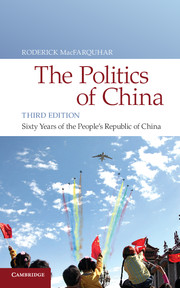Book contents
- Frontmatter
- Contents
- Tables and Maps
- Preface
- Abbreviations
- Introduction
- Chapter 1 The establishment and consolidation of the new regime, 1949–1957
- Chapter 2 The great leap forward and the split in the Yan'an leadership 1958–1965
- Chapter 3 The Chinese State in crisis, 1966–1969
- Chapter 4 The succession to Mao and the end of Maoism, 1969–1982
- Chapter 5 The road to Tiananmen: Chinese politics in the 1980s
- Chapter 6 Reaction, Resurgence, and Succession: Chinese Politics since Tiananmen
- Chapter 7 Dilemmas of globalization and governance
- Appendix Leaders and Meetings
- References
- Index
- References
Chapter 5 - The road to Tiananmen: Chinese politics in the 1980s
Published online by Cambridge University Press: 05 June 2012
- Frontmatter
- Contents
- Tables and Maps
- Preface
- Abbreviations
- Introduction
- Chapter 1 The establishment and consolidation of the new regime, 1949–1957
- Chapter 2 The great leap forward and the split in the Yan'an leadership 1958–1965
- Chapter 3 The Chinese State in crisis, 1966–1969
- Chapter 4 The succession to Mao and the end of Maoism, 1969–1982
- Chapter 5 The road to Tiananmen: Chinese politics in the 1980s
- Chapter 6 Reaction, Resurgence, and Succession: Chinese Politics since Tiananmen
- Chapter 7 Dilemmas of globalization and governance
- Appendix Leaders and Meetings
- References
- Index
- References
Summary
Introduction
By the time the Twelfth Party Congress met in September 1982, China's new leaders had done much to overcome the post-Mao crisis of confidence. They had repudiated Mao's Cultural Revolution, renounced his economic theories, and reinstated his purged opponents. But acknowledging past mistakes was one thing; charting a viable course for the future was quite another. Although members of the reform coalition forged by Deng Xiaoping could agree among themselves, in principle, on the need for economic reform and opening up to the outside world, they differed over just how far and how fast to move toward revamping the basic ideology and institutions of Chinese socialism. Most important, they differed over precisely how much “bourgeois liberalization,” if any, could be countenanced in a society that continued to call itself Marxist–Leninist.
- Type
- Chapter
- Information
- The Politics of ChinaSixty Years of The People's Republic of China, pp. 337 - 467Publisher: Cambridge University PressPrint publication year: 2011
References
- 2
- Cited by

